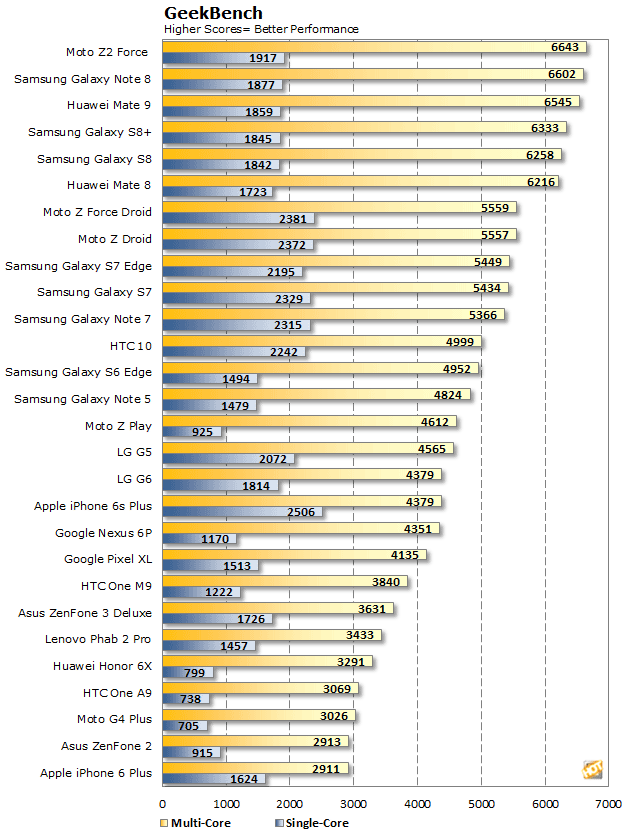Smartphones are increasingly becoming the way many people access the Internet. A smartphone needs to have a responsive web browser system to render complex pages fast, along with a reliable cell or Wi-Fi connection. We can’t easily, quantitatively state how well these radios perform in various phones, as the variables between carriers and access points are too difficult to lock down, but we
can investigate browser performance between devices.
For our first tests we're using the JetStream benchmark for
Javascript and RightWare’s Web Test 3.0 for comprehensive web performance analysis, including
HTML5 rendering. Here we'll primarily determining how the Qualcomm
Snapdragon 835's core CPU architecture handles this workload, along with the Note 8's web browser...
 |
|
JetStream and BrowserMark |
| JavaScript and Browser Testing |
|
The Galaxy Note 8 trailed the Galaxy S8/S8+ by a small margin in both tests. Although the Note 8 has the same SoC, more memory, and is the newer device, differences in software and tweaks to the power profile on the Note 8 are the likely reasons for its slightly lower performance. Overall though, the Note 8 is still one of the fastest smartphones available according to these tests.
 |
|
AnTuTu 6 |
|
Platform Benchmarks |
|
AnTuTu’s latest benchmark returns a number of metrics ranked with somewhat nebulous scores, rather than frame rates or time to complete. We tested with the latest version of AnTuTu across all platforms including Android, iOS and even Windows Phone. AnTuTu returns four top level performance metric results that we are including here: CPU, RAM, 3D, UX (or User Experience), along with a total score.
The Note 8 performed very well in the AnTuTu benchmark, it trailed the Moto Z2 Force by a small margin in the overall score, due to a lower CPU score. In the other sub-tests, however, the Note 8 put up class-leading numbers.
 |
|
Geekbench |
|
Synthetic CPU Testing |
|
In the GeekBench test, we're stressing only CPU cores in a handset (not graphics), with both single and multi-threaded workloads. The test is comprised of encryption processing, image compression, HTML5 parsing, physics calculations, and other general purpose compute processing.
We saw more of the same in GeekBench. The Note 8 trailed the Moto Z2 Force by a small margin, but finished right up there at the top of the heap.
 |
|
Futuremark PCMark For Android |
|
General Purpose Pocket Computing Performance Metrics |
|
Futuremark's PCMark for Android is a new benchmark addition here for us, so we have fewer results in our database of tested phones to show you. However, this is an excellent suite of tests that we highly recommend for benchmarking performance of a handset with heavier-duty tasks for things like image and video editing, as well as lighter-duty workloads like email, and web browsing. When you see the test running live it's clear the scripted application tests are carefully selected and tuned to make use of the platforms involved in a very controlled way.
In terms of overall system performance according to PCMark For Android, the Galaxy Note 8 is an excellent performer. It trailed the Galaxy S8 overall, but had a distinct advantage in the video editing test, most likely because of the phone's 6GB of DDR4 RAM.
AnTuTu’s latest benchmark returns a number of metrics ranked with nebulous scores, rather than frame rates or time to complete. We tested with the latest version of AnTuTu across all platforms including Android, iOS and even Windows Phone. AnTuTu returns four top level performance metric results that we are including here: CPU, RAM, 3D, UX (or User Experience), along with a total score.











